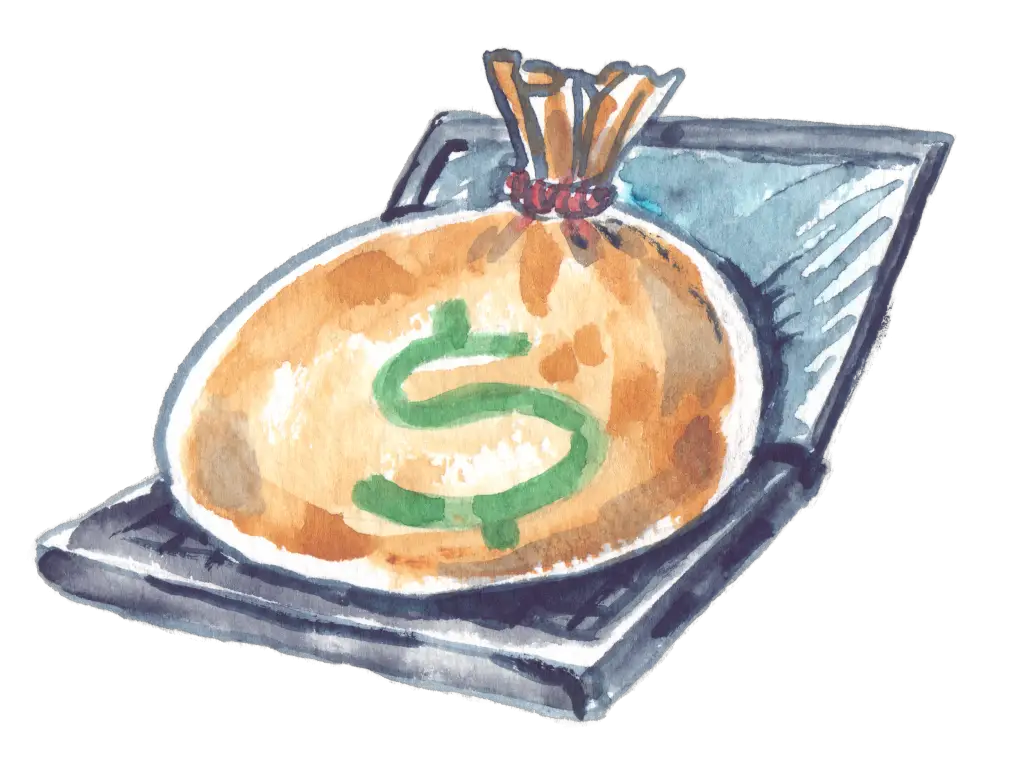
CommonCentsMom.com is advertiser-supported: we may earn compensation from the products and offers mentioned in this article. However, any expressed opinions are our own and aren't influenced by compensation. The contents of the CommonCentsMom.com website, such as text, graphics, images, and other material contained on this site (“Content”) are for informational purposes only. The Content is not intended to be a substitute for professional financial or legal advice. Always seek the advice of your Financial Advisor, CPA and Lawyer with any questions you may have regarding your situation. Never disregard professional advice or delay in seeking it because of something you have read on this website!
What are your financial goals for the next ten years? Are you hoping to retire by 40? Or you want to have a family and will be prepared to do so by the time you are 25.
Goal-setting is effective, and that’s the main reason. Setting objectives is an excellent concept if you want to succeed in your career or business. An excellent goal-setting method is to create a plan for yourself that outlines your goals and a timeline for achieving them.
The end of the financial year is an excellent opportunity to reflect on your financial objectives and review your credit report to see how far you’ve come. Additionally, it’s a perfect chance to change directions, if necessary, in time for a tax refund.
You have the power to impact what you want to happen tomorrow, in a year, or ten years with the help of your financial goal-setting. Without a clear objective, there is a significant chance that your success and the path to getting there will happen by coincidence.
Who Needs Goal Setting?
Setting a goal makes it simpler, regardless of whether you work in sales, are beginning your own business, already operate your own business, are a manager, or want to lose weight.
A team of Harvard academics planned to carry out an extensive study on goal setting between 1979 and 1989. They interviewed many MBA program grads and posed the following approach:
“Have you established clear written goals for your future and plans to achieve them?”
According to the study, 10% of graduates had a goal in mind, 60% had ambitions and desires, and 27% had yet to decide what they wanted. Only 3% of grads had a specific, written-down aim. The students were checked up 20 years later, and the findings were as follows:
The 3% of those with specific, documented goals were wealthier than the other 97%. Numerous times, comparable polls have been conducted with identical outcomes.
Money is not the primary determinant of success, but this idea may be applied to whatever goal you have.
Why Don’t People Make Goals Most Of The Time?
The most frequent reasons why people avoid creating goals are:
- You are unaware of its significance.
- You worry about failing.
- You’re apprehensive about being seen by others. You need to gain the necessary knowledge.
Long-Term Goal-Setting Categories

A goal may be anything, but it must be something you want to happen and are prepared to go above and beyond to accomplish. Here are some typical long-term goal-setting categories; selecting one long-term goal in each category is good. You just have to remove some expenses to save money.
We could provide you so many financial planning tips and advice. We have, however, limited it to those who can assist you with your money in 2023.
1. Personal And Moral Goals
Whom do you want to be? “Your perfect self.” Most likely, you have a role model. List the person’s strengths in writing. Read and watch movies. Consider the person’s behavior in your current circumstance. This will offer you a clear idea of how you may develop objectives that fit your personality.
2. Create An Emergency Fund
An emergency reserve is money set aside mainly to cover unforeseen costs. $500 to $1,000 is a reasonable starting point. When you reach that goal, you should increase it so that your emergency fund can handle more severe financial challenges, including being laid off.
You probably wished you had an emergency fund if you didn’t have one before the COVID-19 outbreak. And if you had one, you could have used all of it and now need to restock.
To meet your obligations and basic needs, Ilene Davis, a certified financial planner (CFP) with Financial Independence Services in Cocoa, Florida, advises saving at least three months’ worth of money, but ideally six months’ worth—especially if you are married, work for the same employer as your spouse, or live in a place with few job opportunities.
According to her, choosing at least one area of your spending where you can cut back will help you pay for your emergency reserves.
According to Kevin Gallegos, vice president of sales and Phoenix operations for Freedom Financial Network, an online financial services provider for consumer debt settlement, mortgage shopping, and personal loans, organizing and decluttering are other ways to save emergency money.
Selling unnecessary stuff on eBay, Craigslist, or yard sales can earn additional cash. Think about making a passion a part-time job so you may put the money earned toward savings.
3. Pay off Credit Cards
Experts are divided on whether to start building an emergency fund or paying off credit card debt first. Some people argue that even if you have credit card debt, you should still establish an emergency fund since, in the absence of one, any unforeseen expenses will increase your credit card debt.
Others advise paying off credit card debt first since attaining other financial goals is much more challenging because the interest is so expensive. Choose the ideology that connects with you the most, or combine aspects of both.
Ilene Davis advises making the minimum payment on everything except your highest-rate loan after arranging all your bills by interest rate, starting from the lowest to the highest. Make additional payments on your highest-rate card using any excess money you may have.
The debt avalanche is the method Davis explains. The debt snowball is another strategy to take into account. Regardless of the interest rate, you pay off your debts using the snowball approach from smallest to greatest.
The idea is that once you pay off your smallest loan, you’ll feel motivated to take on your next-smallest bill, and so on, until you’re debt-free.
4. Estimate Your Retirement Needs
- Calculate the yearly costs of living you want to have in retirement. In retirement, you need to budget for more extraordinary healthcare expenses. You may estimate how much money you’ll need based on your budget when you first set out to achieve your long-term financial goals.
- Subtract the anticipated income. Include Social Security, pensions, and retirement plans. You will then have the amount that your investment portfolio needs to finance.
- Calculate the number of retirement investments you’ll require to reach your ideal retirement age. Base this on your current amount and the amount you save each year.
- You may conduct the calculations using an online retirement calculator. You are scheduled to retire if 4% or less of this balance at retirement covers the remaining costs that Social Security and pension benefits are taken together do not cover.
5. Save More For Retirement

According to CFP Vincent Oldre, president of Assured Retirement Group in Minneapolis, the company will often match a portion of your salary if you have an employer-sponsored retirement plan.
The most crucial action you can take to fund your retirement is to make enough contributions to receive your full employer match. They may match up to 7% or 3% of your salary. If you do this, you may earn a 100% return on your investment.
The fact that many choose not to contribute to their retirement plans because they “can’t afford to” or “are afraid of the stock market” irritates me. They pass up what I refer to as a “no-brainer” return, claims Oldre.
6. Do Your Debts First, Then Your Investments
Doing your debt before your investments is one of the most significant finance advice recommendations for 2023. Your investment is what you may sell in the future and profit from; your debt is what you have to pay back.
Your financial planning for the remainder of the year will be ruined if you don’t pay off your debt as soon as you can.
Additionally, it would be best if you had little to no debt so that you may utilize the money you’re saving now to make more significant investments down the road.
You’ll be able to make more significant investments and get a larger return if you make sure that your most expensive debts are paid off first. Suppose you have to pick between paying off your debts and investing.
If you do this, you’ll have the highest chance of succeeding in your financial objectives in 2023.
7. Plan Your Tax Return
Consider how limiting the effect of taxes on your portfolio may help you develop and maintain your wealth over time, regardless of whether you reside in a state with high taxes or not.
For instance, a tax-aware asset placement strategy, which takes into account the variations in the taxation of various account types, may aid in boosting after-tax returns. Additionally, a technique known as tax-loss harvesting for taxable accounts can reduce the amount of capital gains taxes owing.
Consider financing your 401(k), or another employer-sponsored retirement plan, in full if you haven’t previously because you may make pretax contributions.
Your 401(k) plan allows you to save up to $20,500 in 2023, with older savers (50 and over) contributing an extra $6,500. Additionally, you can contribute up to $6,000 to an IRA for the 2023 tax year, plus an additional $1,000 if you are 50 or older.
8. Update Your Estate Plan
Investors can regularly revise their wills and other estate planning papers. The end of the year might be an excellent time to assess your family’s changes from the previous year and your overall estate plan to make sure it still accurately represents your circumstances and goals.
People who want to make financial presents to family members should be aware of the $16,000 ($32,000 for couples) yearly gift tax exclusion limit for 2023 and try to do it before the year ends.
Individual states frequently have more minor exclusions, even though the federal estate tax exemption increased to $12.06 million for people in 2022. Given that, you may give your family a portion of your fortune today to assist them with their financial situation.
To lessen your overall estate tax obligation, think about creating trusts, giving, and paying for a family member’s education through a 529 plan or a direct donation to a facility.
9. Plan Your Holiday And Charitable Giving

Many people feel inspired to help others over the holidays. It would help if you choose whether you want to donate money, valued securities, or your time as a present while formulating your gifting arrangements.
A donor-advised fund is another way to give back; it may offer tax benefits while assisting you in supporting your preferred causes. Consider setting up a family foundation to involve your relatives in your charity if you’re more serious about developing a more substantial structure and commitment.
Set a budget for projected year-end spending before starting to buy gifts for everyone on your list, keeping in mind any service providers and important individuals in your life you’d like to reward with Christmas bonuses.
Final Thoughts
The most important thing is to stay persistent even if you don’t make perfect, linear progress toward your goals.
Don’t be upset with yourself if you have to withdraw money from your emergency fund one month because you have an unexpected car repair or medical cost; that’s why the fund is there. Just as soon as you can, get going again.
The same is true if you get sick or lose your work. You may not be able to pay off debt or put money away for retirement during that challenging time, but you may restart your original plan—or possibly a revised version—when you have overcome the difficult phase.
The beauty of yearly financial planning is that you may examine, revise, and track your progress toward your goals during life’s ups and downs.
In the process, you’ll discover that both the modest actions you take on a daily and monthly basis and the larger ones you do on an annual and lifetime basis will assist in achieving your financial goals for 2023.







